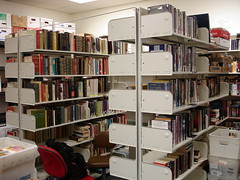 I did three presentations yesterday for Community College instructors and administrators. During a conversation about Web 2.0 and “the new shape of information” the librarian reported that they had been studying the use of their library. They found that of all the books they have purchased since 2003, 60% have never been checked out.
I did three presentations yesterday for Community College instructors and administrators. During a conversation about Web 2.0 and “the new shape of information” the librarian reported that they had been studying the use of their library. They found that of all the books they have purchased since 2003, 60% have never been checked out.
Now this is way too complex an issue for me to draw any conclusions about. But you librarians among the readers of this blog, what do you think this means?
Image Citation
Librarian, Travelin. “New Backroom Shelving.” Travelinlibrarian’s Photostream. 11 Oct 2006. 9 Nov 2006 <http://flickr.com/photos/travelinlibrarian/267377556/>.
technorati tags:warlick, education, library, books, technology
Blogged with Flock

In my high school, I observe the same trend though I don’t have numbers yet to document it. Our fiction section is still highly active as are a few areas in nonfiction.(anime, biographies)
But for the most part, students are doing much more research online, even while in the library(we have two computer labs).
I’ve been tailoring my purchasing differently–purchasing more audio and audio download books, funding databases subscriptions more and buying reference “sets” that will give an overall view of a topic and will last, rather than as many individual titles on each subject area. I”ve also gravitated towards reference books that are much more visual since I think they will get used more.
My library is about to be renovated and I think one of the barriers is that we have these massive 1960’s bookshelves. So we will be replacing those with lower bookstore style shelving, which I do think will draw students into the stacks more. We are also going to change our signage(after an article I read about Carnegie Library doing this) to bookstore signage, rather than “Dewey” oriented signage. By bookstore, I mean, hang signs that say “History” or “Cookbooks” rather than “Nonfiction 600’s”.
(I think most college libraries have more of a challenge because they can’t really create that bookstore model in the stacks.)
I think like everything else, though, internet use and Web 2.0 are going to require that we rethink our environments and how they function so that we better meet users than they are, instead of them having to learn our lingo.
My “two cents worth”…
One thing it means quite clearly is that there is NOT a long tail within a school library.
I work at the library that David is referring to, and the books that usually get checked out are bestselling fiction and subjects like “abortion” or “civil rights” for research papers (usually because their teachers require a source from a printed book!). I worked at Barnes & Noble for five long years and I, too, think it would be valuable to look at bookstores for ideas. I mean, people these days treat bookstores like libraries anyway, and vice versa! Customers were mad when they couldn’t concentrate while reading our merchandise in the cafe because of a screaming child or our choice of “best of the 80’s” music. And library patrons expect coffee and the permission to speak as loud as possible on their cellphones! The idea of hanging signs like “Cooking” and “History” is great. Sometimes I’m baffled by the categorization within the Dewey system (especially after working at B&N!), so I’m sure students/patrons are as well. I mean, if I were going to look for “Brave New World” I would immediately go to “Fiction,” not down in the stacks with the “Non-Fiction”…right?!?! 😉 Anyway, the possibilities are endless I suppose.
By the way, thanks David for coming to GTCC!!!